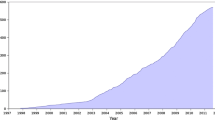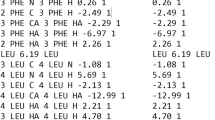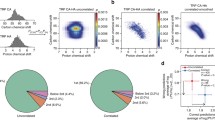Abstract
In solution NMR spectroscopy the residual dipolar coupling (RDC) is invaluable in improving both the precision and accuracy of NMR structures during their structural refinement. The RDC also provides a potential to determine protein structure de novo. These procedures are only effective when an accurate estimate of the alignment tensor has already been made. Here we present a top–down approach, starting from the secondary structure elements and finishing at the residue level, for RDC data analysis in order to obtain a better estimate of the alignment tensor. Using only the RDCs from N–H bonds of residues in α-helices and CA–CO bonds in β-strands, we are able to determine the offset and the approximate amplitude of the RDC modulation-curve for each secondary structure element, which are subsequently used as targets for global minimization. The alignment order parameters and the orientation of the major principal axis of individual helix or strand, with respect to the alignment frame, can be determined in each of the eight quadrants of a sphere. The following minimization against RDC of all residues within the helix or strand segment can be carried out with fixed alignment order parameters to improve the accuracy of the orientation. For a helical protein Bax, the three components A xx , A yy and A zz , of the alignment order can be determined with this method in average to within 2.3% deviation from the values calculated with the available atomic coordinates. Similarly for β-sheet protein Ubiquitin they agree in average to within 8.5%. The larger discrepancy in β-strand parameters comes from both the diversity of the β-sheet structure and the lower precision of CA–CO RDCs. This top-down approach is a robust method for alignment tensor estimation and also holds a promise for providing a protein topological fold using limited sets of RDCs.






Similar content being viewed by others
References
Al-Hashimi HM, Valafar H, Terrell M, Zartler ER, Eidsness MK, Prestegard JH (2000) Variation of molecular alignment as a means of resolving orientational ambiguities in protein structures from dipolar couplings. J Magn Reson 143:402–406
Bax A (2003) Weak alignment offers new NMR opportunities to study protein structure and dynamics. Protein Sci 12:1–16
Bax A, Kontaxis G, Tjandra N (2001) Dipolar couplings in macromolecular structure determination. Methods Enzymol 339:127–174
Blackledge M (2005) Recent progress in the study of biomolecular structure and dynamics in solution from residual dipolar couplings. Prog NMR Spectrosc 46:23–61
Bouvignies G, Meier S, Grzesiek S, Blackledge M (2006) Ultrahigh-resolution backbone structure of perdeuterated protein GB1 using residual dipolar couplings from two alignment media. Angew Chem Int Ed Engl 45:8166–8169
Bryce DL, Bax A (2004) Application of correlated residual dipolar couplings to the determination of the molecular alignment tensor magnitude of oriented proteins and nucleic acids. J Biomol NMR 28:273–287
Clore GM, Gronenborn AM, Bax A (1998) A robust method for determining the magnitude of the fully asymmetric alignment tensor of oriented macromolecules in the absence of structural information. J Magn Reson 133:216–221
Clore GM, Schwieters CD (2004) How much backbone motion in ubiquitin is required to account for dipolar coupling data measured in multiple alignment media as assessed by independent cross-validation? J Am Chem Soc 126:2923–2938
Cornilescu G, Delaglio F, Bax A (1999) Protein backbone angle restraints from searching a database for chemical shift and sequence homology. J Biomol NMR 13:289–302
Cornilescu G, Marquardt JL, Ottiger M, Bax A (1998) Validation of protein structure from anisotropic carbonyl chemical shifts in a dilute liquid crystalline phase. J Am Chem Soc 120: 6836–6837
de Alba E, Tjandra N (2002) NMR dipolar couplings for the structure determination of biopolymers in solution. Prog NMR Spectrosc 40:175–197
Eisenberg D, Weiss RM, Terwilliger TC (1984) The hydrophobic moment detects periodicity in protein hydrophobicity. Proc Natl Acad Sci USA 81:140–144
Fowler CA, Tian F, Al-Hashimi HM, Prestegard JH (2000) Rapid determination of protein folds using residual dipolar couplings. J Mol Biol 304:447–460
Grishaev A, Wu J, Trewhella J, Bax A (2005) Refinement of multidomain protein structures by combination of solution small-angle X-ray scattering and NMR data. J Am Chem Soc 127:16621–16628
Hansen MR, Mueller L, Pardi A (1998) Tunable alignment of macromolecules by filamentous phage yields dipolar coupling interactions. Nat Struct Biol 5:1065–1074
Hus JC, Marion D, Blackledge M (2001) Determination of protein backbone structure using only residual dipolar couplings. J Am Chem Soc 123:1541–1542
Kontaxis G, Delaglio F, Bax A (2005) Molecular fragment replacement approach to protein structure determination by chemical shift and dipolar homology database mining. Methods Enzymol 394:42–78
Lipsitz RS, Tjandra N (2003) 15N chemical shift anisotropy in protein structure refinement and comparison with NH residual dipolar couplings. J Magn Reson 164:171–176
Lipsitz RS, Tjandra N (2004) Residual dipolar couplings in NMR structure analysis. Annu Rev Biophys Biomol Struct 33:387–413
Marassi FM (2001) A simple approach to membrane protein secondary structure and topology based on NMR spectroscopy. Biophys J 80:994–1003
Mascioni A, Eggimann BL, Veglia G (2004) Determination of helical membrane protein topology using residual dipolar couplings and exhaustive search algorithm: application to phospholamban. Chem Phys Lipids 132:133–144
Mascioni A, Veglia G (2003) Theoretical analysis of residual dipolar coupling patterns in regular secondary structures of proteins. J Am Chem Soc 125:12520–12526
Meier S, Haussinger D, Jensen P, Rogowski M, Grzesiek S (2003) High-accuracy residual 1HN-13C and 1HN-1HN dipolar couplings in perdeuterated proteins. J Am Chem Soc 125:44–45
Mesleh MF, Lee S, Veglia G, Thiriot DS, Marassi FM, Opella SJ (2003) Dipolar waves map the structure and topology of helices in membrane proteins. J Am Chem Soc 125:8928–8935
Mesleh MF, Opella SJ (2003) Dipolar Waves as NMR maps of helices in proteins. J Magn Reson 163:288–299
Ottiger M, Bax A (1998) Determination of relative N–H–N N–C′, C-alpha-C’, andC(alpha)-H-alpha effective bond lengths in a protein by NMR in a dilute liquid crystalline phase. J Am Chem Soc 120:12334–12341
Prestegard JH (1998) New techniques in structural NMR–anisotropic interactions. Nat Struct Biol 5(Suppl ): 517–522
Prestegard JH, Bougault CM, Kishore AI (2004) Residual dipolar couplings in structure determination of biomolecules. Chem Rev 104:3519–3540
Prestegard JH, Mayer KL, Valafar H, Benison GC (2005) Determination of protein backbone structures from residual dipolar couplings. Methods Enzymol 394:175–209
Prestegard JH, Valafar H, Glushka J, Tian F (2001) Nuclear magnetic resonance in the era of structural genomics. Biochemistry 40:8677–8685
Schwieters CD, Kuszewski JJ, Tjandra N, Clore GM (2003) The Xplor-NIH NMR molecular structure determination package. J Magn Reson 160:65–73
Skrynnikov NR, Kay LE (2000) Assessment of molecular structure using frame-independent orientational restraints derived from residual dipolar couplings. J Biomol NMR 18:239–252
Suzuki M, Youle RJ, Tjandra N (2000) Structure of Bax: coregulation of dimer formation and intracellular localization. Cell 103:645–654
Tian F, Fowler CA, Zartler ER, Jenney FA Jr, Adams MW, Prestegard JH (2000) Direct measurement of 1H-1H dipolar couplings in proteins: a complement to traditional NOE measurements. J Biomol NMR 18:23–31
Tjandra N, Bax A (1997) Direct measurement of distances and angles in biomolecules by NMR in a dilute liquid crystalline medium. Science 278:1111–1114
Tolman JR, Flanagan JM, Kennedy MA, Prestegard JH (1995) Nuclear magnetic dipole interactions in field-oriented proteins: information for structure determination in solution. Proc Natl Acad Sci USA 92:9279–9283
Tolman JR, Ruan K (2006) NMR residual dipolar couplings as probes of biomolecular dynamics. Chem Rev 106:1720–1736
Walsh JD, Kuszweski J, Wang YX (2005) Determining a helical protein structure using peptide pixels. J Magn Reson 177:155–159
Walsh JD, Wang YX (2005) Periodicity, planarity, residual dipolar coupling, and structures. J Magn Reson 174:152–162
Wu CH, Ramamoorthy A, Opella SJ (1994) High-resolution heteronuclear dipolar solid-state Nmr-spectroscopy. J Magn Reson A 109:270–272
Wu Z, Delaglio F, Wyatt K, Wistow G, Bax A (2005) Solution structure of (gamma)S-crystallin by molecular fragment replacement NMR. Protein Sci 14:3101–3114
Acknowledgements
We thank Charles Schwieters for providing the Ubiquitin RDC data and Robert Burton for helpful discussion. This work was supported by the Intramural Research Program of the NIH, National Heart, Lung, and Blood Institute.
Author information
Authors and Affiliations
Corresponding author
Rights and permissions
About this article
Cite this article
Chen, K., Tjandra, N. Top-down approach in protein RDC data analysis: de novo estimation of the alignment tensor. J Biomol NMR 38, 303–313 (2007). https://doi.org/10.1007/s10858-007-9168-4
Received:
Accepted:
Published:
Issue Date:
DOI: https://doi.org/10.1007/s10858-007-9168-4




